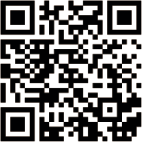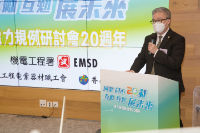 Mr. Poon Kwok-ying, Acting Deputy Director of Electrical and Mechanical Services delivered the opening speech for the Seminar.
Mr. Poon Kwok-ying, Acting Deputy Director of Electrical and Mechanical Services delivered the opening speech for the Seminar.
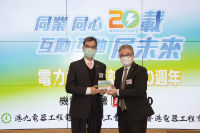 Mr. Poon Kwok-ying, Acting Deputy Director of Electrical and Mechanical Services presented a souvenir to Mr. Wai Yip-kin, Chairman of the Hong Kong Electrical Contractors' Association.
Mr. Poon Kwok-ying, Acting Deputy Director of Electrical and Mechanical Services presented a souvenir to Mr. Wai Yip-kin, Chairman of the Hong Kong Electrical Contractors' Association.
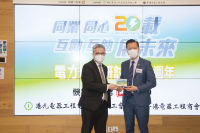 Mr. Poon Kwok-ying, Acting Deputy Director of Electrical and Mechanical Services presented a souvenir to Mr. Lok Kwei-sang, Chairman of the Hong Kong & Kowloon Electrical Engineering & Appliances Trade Workers Union.
Mr. Poon Kwok-ying, Acting Deputy Director of Electrical and Mechanical Services presented a souvenir to Mr. Lok Kwei-sang, Chairman of the Hong Kong & Kowloon Electrical Engineering & Appliances Trade Workers Union.
 A group photo taken featuring Mr. Poon Kwok-ying, Acting Deputy Director of Electrical and Mechanical Services; Mr. Lok Kwei-sang, Chairman of the Hong Kong & Kowloon Electrical Engineering & Appliances Trade Workers Union; Mr. Wai Yip-kin, Chairman of the Hong Kong Electrical Contractors' Association; and other guests.
A group photo taken featuring Mr. Poon Kwok-ying, Acting Deputy Director of Electrical and Mechanical Services; Mr. Lok Kwei-sang, Chairman of the Hong Kong & Kowloon Electrical Engineering & Appliances Trade Workers Union; Mr. Wai Yip-kin, Chairman of the Hong Kong Electrical Contractors' Association; and other guests.
Since 2001, the EMSD has organised the Annual Technical Seminar jointly with the Hong Kong & Kowloon Electrical Engineering & Appliances Trade Workers Union (the Union) and the Hong Kong Electrical Contractors' Association (the Association). This year, we have the 20th Seminar.
The Seminar this year was originally scheduled to be held in the form of on-site seminar at Tsuen Wan Town Hall. Having regard to the development of the COVID-19 epidemic and the Government's epidemic prevention guidelines, the Seminar was held for the first time in the form of video conference on 26 January 2021 and was concluded successfully.
At the Seminar, Mr. Lok Kwei-sang, Chairman of the Hong Kong & Kowloon Electrical Engineering & Appliances Trade Workers Union; Mr. Wai Yip-kin, Chairman of the Hong Kong Electrical Contractors' Association; and Mr. Poon Kwok-ying, Acting Deputy Director of Electrical and Mechanical Services delivered the opening speeches. Mr. Poon thanked the Union and the Association for their unfailing support for the Seminar over the years. They maintained solidarity among members of the electrical trade to explore together and exchange views on electrical safety as well as the challenges and opportunities regarding the development of the electrical trade, contributing to a continuous reduction in the number of electrical accidents with a view to achieving the long-term goal of zero accident. Besides, Mr. Poon and Mr. Chu Kei-ming, Acting Assistant Director of Electrical and Mechanical Services presented souvenirs to the two officiating guests and the speakers.
The 2020 edition of the Code of Practice for the Electricity (Wiring) Regulations (CoP) was published in December last year. Mr. Sze Chung-tak, Electrical and Mechanical Engineer of the EMSD, briefed the trade on the main revisions of the new edition of the CoP, including the arrangement of the USB final circuits and the latest safety requirements for provision of residual current protection in electrical installations of village houses. Besides, Mr. C. K. Wong, Engineer of the Association also shared his experience on Electrical Safe Systems of Work. In the second half of the Seminar, Mr. W. K. Chan, Chief Inspection and Technical Support Engineer of the Hong Kong Electric Co. Ltd.; and Mr. C. S. Cheung, Engineer I of the CLP Power Hong Kong Limited explained the "EV-charging at Home Subsidy Scheme" for electric vehicles, and the update on the technical requirements on grid connection of renewable energy power systems respectively.
The Seminar was well received, attracting nearly 1 000 participants from the electrical trade. The Seminar aims at continuously enhancing the safety work culture and professional standards of the electrical trade, and creating opportunities for more diversified development in their work of the professionals of the trade.
In the future, the EMSD will continue to organise the Seminar with the Union and the Association. The registration details will be announced later. We hope that the trade will participate actively and share their valuable experience together.
 [PDF format (2.02MB)]
[PDF format (2.02MB)] [PDF format (2.74MB)]
[PDF format (2.74MB)]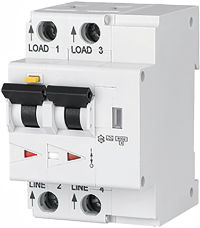 About 20% to 30% of fire incidents are related to electrical installations worldwide each year and arc fault is one of the causes of electrical-installation-related fire. Possible causes of arc faults include improper installation of cables, intermittent connection or damaged cable insulators. The high temperature resulting from arc faults may cause fire. Since existing mainstream protection devices (overload circuit breakers and residual current devices) are unable to detect some types of art faults, countries across the globe have one after another recommended or mandatorily required the installation of AFDDs in specific venues. In view of the above, the CoP makes reference to the 18th Edition of the Institution of Engineering and Technology Wiring Regulations and recommends that AFDDs complying with IEC 62606 or equivalent should be installed at the following specific premises to further safeguard electricity safety:
About 20% to 30% of fire incidents are related to electrical installations worldwide each year and arc fault is one of the causes of electrical-installation-related fire. Possible causes of arc faults include improper installation of cables, intermittent connection or damaged cable insulators. The high temperature resulting from arc faults may cause fire. Since existing mainstream protection devices (overload circuit breakers and residual current devices) are unable to detect some types of art faults, countries across the globe have one after another recommended or mandatorily required the installation of AFDDs in specific venues. In view of the above, the CoP makes reference to the 18th Edition of the Institution of Engineering and Technology Wiring Regulations and recommends that AFDDs complying with IEC 62606 or equivalent should be installed at the following specific premises to further safeguard electricity safety: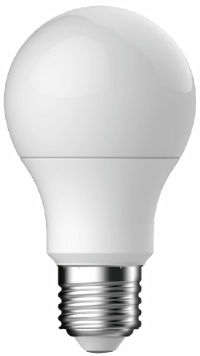 In view of the growing popularity of environmentally friendly lighting fittings (e.g. LED lamps) with much lower electricity consumption compared to traditional lighting fittings, the calculation method of the assumed current demand and the current demand of final circuit in relation to lighting outlets as stipulated in the CoP has been revised. Lighting outlets should be assumed to demand the connected load with 60W per lampholder for incandescent lamps or the actual wattage of the lamp to be installed, whichever is the greater, except if the design of the luminaire associated with the lampholder only permits lamps of less than 60W to be inserted in any lampholder, in which case, the connected load of that lampholder is the wattage of the highest rated lamp that may be accommodated. For fluorescent and other discharge lamps, the demand of the connected load of the lighting outlets should be assumed as the actual wattage of the installed lamps multiplied by a factor which has taken into account control gear losses and harmonic currents. In the absence of more precise information from manufacturer, a factor of not less than 1.8 shall be adopted.
In view of the growing popularity of environmentally friendly lighting fittings (e.g. LED lamps) with much lower electricity consumption compared to traditional lighting fittings, the calculation method of the assumed current demand and the current demand of final circuit in relation to lighting outlets as stipulated in the CoP has been revised. Lighting outlets should be assumed to demand the connected load with 60W per lampholder for incandescent lamps or the actual wattage of the lamp to be installed, whichever is the greater, except if the design of the luminaire associated with the lampholder only permits lamps of less than 60W to be inserted in any lampholder, in which case, the connected load of that lampholder is the wattage of the highest rated lamp that may be accommodated. For fluorescent and other discharge lamps, the demand of the connected load of the lighting outlets should be assumed as the actual wattage of the installed lamps multiplied by a factor which has taken into account control gear losses and harmonic currents. In the absence of more precise information from manufacturer, a factor of not less than 1.8 shall be adopted.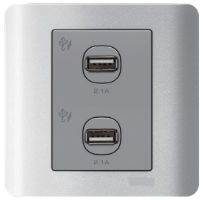
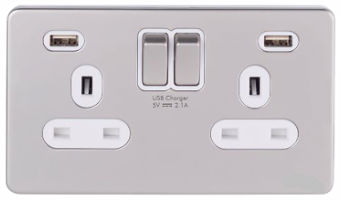
 [PDF format (307KB)]
[PDF format (307KB)]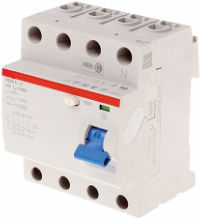 In response to the electrical incidents involving electrical installations at village houses occurred in recent years, the CoP has a new requirement that protection by means of residual current devices shall be provided for electrical installations in premises under the List of Recognized Villages under the New Territories Small House Policy, in order to enhance the electrical safety of village premises. Not only limited to electrical installations at village houses, the requirement is applicable to any premises within relevant village environs. According to the CoP, appropriate circuit breaking function for residual current installed at the main switch immediately before the electric meter or the main switch box of the unit is also acceptable.
In response to the electrical incidents involving electrical installations at village houses occurred in recent years, the CoP has a new requirement that protection by means of residual current devices shall be provided for electrical installations in premises under the List of Recognized Villages under the New Territories Small House Policy, in order to enhance the electrical safety of village premises. Not only limited to electrical installations at village houses, the requirement is applicable to any premises within relevant village environs. According to the CoP, appropriate circuit breaking function for residual current installed at the main switch immediately before the electric meter or the main switch box of the unit is also acceptable.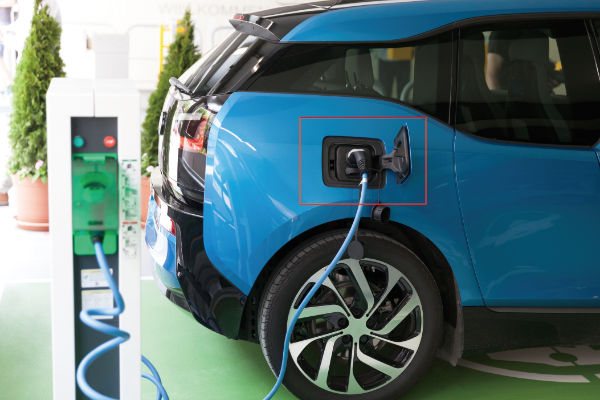
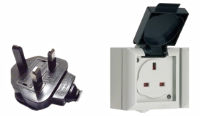


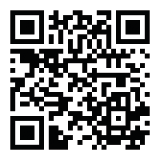

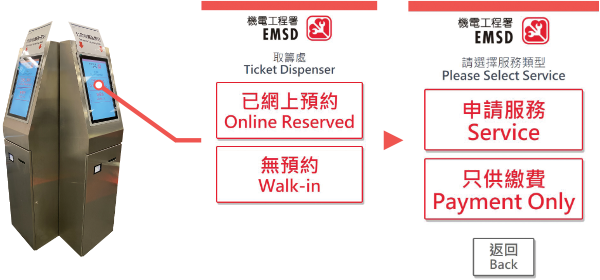
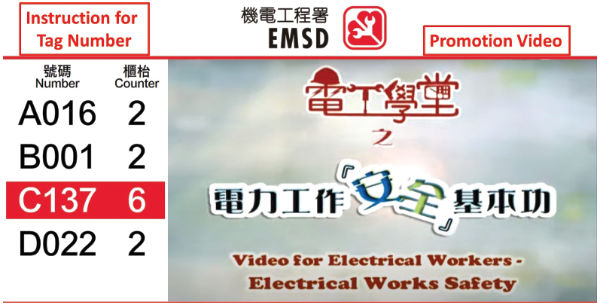
 If the required documents are found to be incomplete or missing at the counter and further preparation is needed, the user could, after the required documents are ready, scan the QR code on the number tag at the kiosk shown on the right, and follow the instruction for the tag number shown on the display panel in the office to proceed to a designated counter for services again. Upon the counter staff's confirmation that all required documents are submitted and the payment of the application fee, the entire application process is complete.
If the required documents are found to be incomplete or missing at the counter and further preparation is needed, the user could, after the required documents are ready, scan the QR code on the number tag at the kiosk shown on the right, and follow the instruction for the tag number shown on the display panel in the office to proceed to a designated counter for services again. Upon the counter staff's confirmation that all required documents are submitted and the payment of the application fee, the entire application process is complete.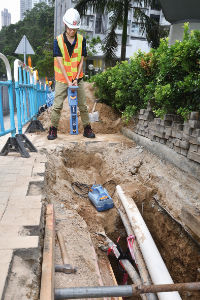
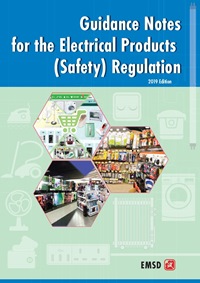 [PDF format (7.81MB)]
[PDF format (7.81MB)]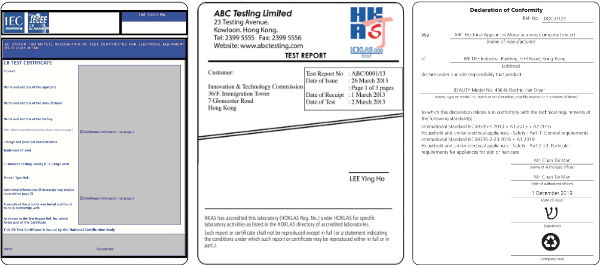
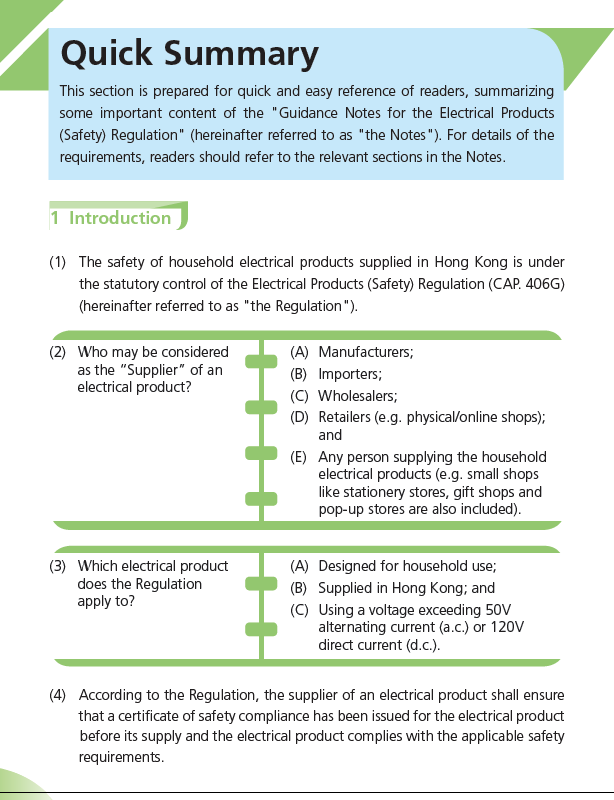

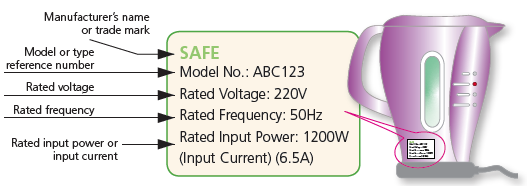
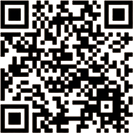
 Mr. Poon Kwok-ying, Acting Deputy Director of Electrical and Mechanical Services delivered the opening speech for the Seminar.
Mr. Poon Kwok-ying, Acting Deputy Director of Electrical and Mechanical Services delivered the opening speech for the Seminar. Mr. Poon Kwok-ying, Acting Deputy Director of Electrical and Mechanical Services presented a souvenir to Mr. Wai Yip-kin, Chairman of the Hong Kong Electrical Contractors' Association.
Mr. Poon Kwok-ying, Acting Deputy Director of Electrical and Mechanical Services presented a souvenir to Mr. Wai Yip-kin, Chairman of the Hong Kong Electrical Contractors' Association. Mr. Poon Kwok-ying, Acting Deputy Director of Electrical and Mechanical Services presented a souvenir to Mr. Lok Kwei-sang, Chairman of the Hong Kong & Kowloon Electrical Engineering & Appliances Trade Workers Union.
Mr. Poon Kwok-ying, Acting Deputy Director of Electrical and Mechanical Services presented a souvenir to Mr. Lok Kwei-sang, Chairman of the Hong Kong & Kowloon Electrical Engineering & Appliances Trade Workers Union. A group photo taken featuring Mr. Poon Kwok-ying, Acting Deputy Director of Electrical and Mechanical Services; Mr. Lok Kwei-sang, Chairman of the Hong Kong & Kowloon Electrical Engineering & Appliances Trade Workers Union; Mr. Wai Yip-kin, Chairman of the Hong Kong Electrical Contractors' Association; and other guests.
A group photo taken featuring Mr. Poon Kwok-ying, Acting Deputy Director of Electrical and Mechanical Services; Mr. Lok Kwei-sang, Chairman of the Hong Kong & Kowloon Electrical Engineering & Appliances Trade Workers Union; Mr. Wai Yip-kin, Chairman of the Hong Kong Electrical Contractors' Association; and other guests.